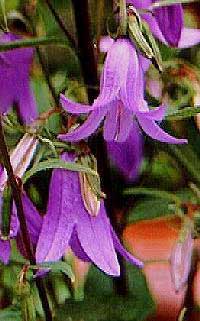Adenophora liliifolia
LADY BELLS
Family: Campanulaceae
Pronounced: ah-den-O-fo-ra lee-lee-i-FO-lee-ah
Quick Jumps
Growing Guide
Rainy Side Notes
GROWING GUIDE

Geographical origin:
Central Europe to Siberia.
Plant group:
Perennial.
Hardiness:
Sunset zones 1-10, 14-24.
USDA zones: 3-8.
Heat zones: 7-1.
Mature size:
Height: 18 inches (45 cm).
Width: 12 inches (30 cm).
Flowering period:
Midsummer.
Flowering attributes
Fragrant, lavender-blue, bell-shaped flowers.
Leaf attributes:
Lance-shaped leaves with hairy stems.
Growth habit
Spreads by underground stems.
Light:
Full sun or partial shade.
Soil:
Humus rich, moist, well-drained soil.
Feeding:
Side dress with compost or manure and fertilize with a complete organic fertilizer in spring.
Feeding:
Sow seeds in late winter indoors at 68ºf (20°) or outside when seed is ripe. | Basal cuttings in late spring. | Division not recommended.
Feeding:
Deadhead to prolong bloom time and prevent plant from seeding. After second flush of flowers are finished, cut plants down to new foliage at the base. Clean up foliage in spring.
Pests and diseases
Slugs and snails may eat young growth.
Rainy Side Notes
There is a sense of elegance in ladybells with her bell shaped, fragrant blossoms and her two to three foot stature. This perennial herb carries her bells proudly on strong stems. Her name is not as elegant as her appearance, with aden meaning a gland and phorea (fruit) referring to the glandular disc at the base of the style. Even less elegant is one of her common names, gland bellflower. All that aside, ladybells are a great addition to any garden which can give her room to roam.
From central Europe and Asia, Adenophora is grown for many uses. A beautiful ornamental, ladybells make a good cut flower. I can fault this perennial only for its running tendencies, but it is easy to keep under control. The Japanese also use Adenophora as a vegetable with the rhizomes cultivated as a root crop. For medicinal purposes, the Chinese use Adenophora stricta, harvesting the roots in fall.
Adenophora germinates easily from seed. Sowing them in mid January, I find the seed germinates for me in seven days. I surface sow the seeds in a seed-starting medium. Water well, cover the flat with a plastic dome and set on top of the refrigerator for warmth. When they germinate, I immediately transplant the seedlings to their own pots and place in the greenhouse. Now that I have a heat mat in the greenhouse for germinating seeds, the top of the refrigerator is free to clutter again with other non-gardening items. Basal cuttings can be taken in spring, but since Lady bells easily come up from seed, I have not done this. I have read that the roots resent disturbance, but in my own experience, they live through my handling of the seedlings while small.
When the weather is on the drier side of July, I transplant the young ones to the garden. This foils the slugs now sleeping through the dry times, giving the young plants a chance to establish themselves. I find this to be the best time to transplant those young plants that slugs love to devour. When transplanting during our drought season, I have to keep a diligent eye out on the watering needs of young transplants until the rains return in fall. If weather is too hot, I wait for a cooler day to transplant. It is a trade off between whether I want to fight the slugs earlier in the rainy season or water more and risk too hot weather for the plants. Once the plants are established, the slugs will sometimes nibble them but will not decimate them entirely. Although I have not observed the problem on my plants, vine weevils may eat the roots.
Lady bells thrive in full sun or partial shade in a rich, moist and well-drained position in the garden. When finished transplanting and watering in well, I then pray for sunnier days ahead. I use a complete organic fertilizer at planting time and keep them well watered the first season. About an inch of water a week is best, and if Mother Nature does not provide it, I help with supplemental watering in July, August and first part of September. I spread a mulch of shredded bark around the plant at this time.
Give this elegant lady a place in your garden and she will reward you with her fragrant lavender bells next summer.
Photographed in author's garden.

Gardening for the Homebrewer: Grow and Process Plants for Making Beer, Wine, Gruit, Cider, Perry, and More
By co-authors Debbie Teashon (Rainy Side Gardeners) and Wendy Tweton
Copyright Notice | Home | Search | Perennials

